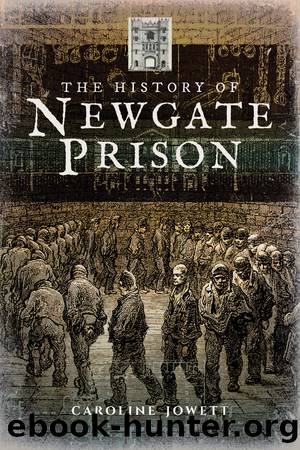The History of Newgate Prison by Jowett Caroline;

Author:Jowett, Caroline;
Language: eng
Format: epub
Publisher: Pen & Sword Books Limited
Published: 2017-08-15T00:00:00+00:00
Chapter 6
The New Newgate 1770 - 1799
Around 1768, in response to a campaign by the former Lord Mayor Sir Stephen Janssen, the Cityâs newly-appointed, 27-year-old architect and surveyor George Dance the Younger was asked to come up with a design for a new gaol and sessions house. Janssen had been at the Black Assizes in 1750 when sixty-four people had died of gaol fever and he had been responsible for the ventilation windmill erected on the roof two years later.
Danceâs design was radical and new; a blueprint for a building in the architecture terrible style that was so monstrously brutal in appearance that its very presence would act as a deterrent to wrongdoers. Or so the authorities hoped.
Unlike the leaky 250-year-old patched-up gatehouse gaol with its grilles and multiple opportunities for begging and escape, the new Newgate was a fortified citadel surrounded by high windowless stone walls. Handily, the building backed onto the Royal College of Physicians in Warwick Lane, which received the corpses of the condemned for dissection in its anatomy classes and it stretched down Old Bailey to where a new sessions house had been commissioned to include a single courtroom and a fancy dining room with a mosaic, a vault of fine wines and an expensive Turkish carpet. There was also a room for witnesses who had previously had to wait in the pub down the road to be called. The sessions house was completed in 1774.
Construction on the gaol started in 1770 when the Lord Mayor William Beckford laid the foundation stone. Newgateâs new facade fronted onto Old Bailey, in the centre was a five-storey brick house where the keeper, Richard Akerman, lived with his family, secure studded doors on other side of this admitted visitors and prisoners to the gaol. There was a connecting door to the sessions house through which prisoners travelled to and from court. By 1775, two of the quads had been completed and the order was given to demolish the rest of the old gaol, the last part to be torn down was the gatehouse itself in 1777. Behind the walls, the prison was three floors high and divided into three discrete areas. The debtorsâ prison held 100, as did the womenâs prison, where there were also state apartments. Between the two was the felonsâ prison, which now held 300 men. Each was built around its own courtyard to allow for exercise and fresh air. There was a chapel, indoor toilets on each of the three floors, taprooms, a coffee room, lodges for the turnkeys and, for the first time, an infirmary. The condemned cells built in 1726 were considered still fit for purpose and were incorporated into the design. It was a vast improvement on the old Newgate.
Akerman felt the new gaol was bigger and airier than before and there was less illness. An illustration of the Marshalsea infirmary from about the same time shows a room with a long platform running most of its length with hammocks suspended above it.
Download
This site does not store any files on its server. We only index and link to content provided by other sites. Please contact the content providers to delete copyright contents if any and email us, we'll remove relevant links or contents immediately.
The 1921 Tulsa Race Massacre by Chris M. Messer(284)
Introduction to Criminal Justice - A Balanced Approach by Brian K. Payne Willard M. Oliver Nancy E. Marion(252)
Russia's Sakhalin Penal Colony, 1849â1917 by Andrew A. Gentes(246)
Punishing the Poor The Neoliberal Government of Social Insecurity by Unknown(246)
The History of Newgate Prison by Jowett Caroline;(234)
Serial Killers America and UK - 2 BOOKS IN 1 by Clark Matthew(209)
A History of Police and Masculinities, 1700-2010 by David G. Barrie Susan Broomhall(195)
Restorative Justice in Transitional Settings by Kerry Clamp(167)
Organized Crime and Corruption Across Borders by T. Wing Lo Dina Siegel Sharon I Kwok(158)
Culture, Crime and Punishment by Ronald Kramer(155)
Cops, Cameras, and Crisis by Michael D. White Aili Malm(153)
Dangerousness, Risk and the Governance of Serious Sexual and Violent Offenders by Karen Harrison(152)
Policing Gender, Class And Family In Britain, 1800-1945 by Linda Mahood(151)
Routledge Handbook on Immigration and Crime by Holly Ventura Miller Anthony Peguero(150)
The Real CSI by Kate Bendelow(148)
Women Exiting Prison by Bree Carlton Marie Segrave(140)
Losing Legitimacy by Gary Lafree(138)
Using Murder by Philip Jenkins(135)
A Theory of African American Offending by James D. Unnever Shaun L. Gabbidon(134)
